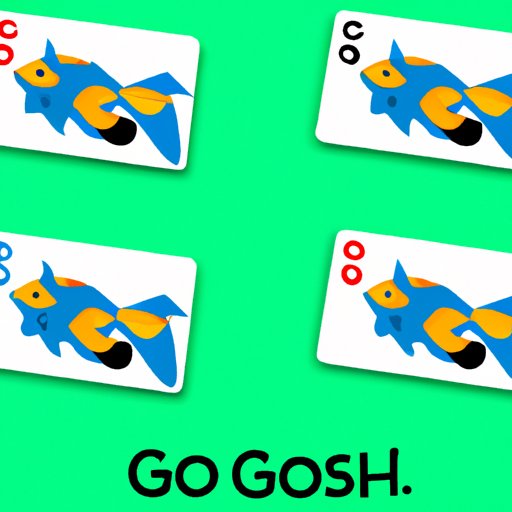Introduction
Go Fish is a classic card game that has been enjoyed by generations of players around the world. It’s a game that is easy to learn but can provide hours of fun and entertainment for players of all ages. In this article, we’ll explore the rules and strategies of Go Fish, as well as fun variations that can add a twist to the game. We’ll also provide tips on how to teach the game to kids, how to be a good sport, and even how to organize a tournament in your community.

The Basics of Go Fish: Rules and Strategies to Win
Go Fish is a game typically played with a standard 52-card deck. The objective of the game is to collect as many sets of cards as possible. A set consists of four cards of the same rank, such as four aces, four kings, and so on. The game can be played with two to six players and is suitable for ages 4 and up.
The game begins with the dealer shuffling the deck and dealing each player five cards. The remaining cards are placed face-down in the middle of the table to create a draw pile. The player to the left of the dealer goes first by asking one of the other players if they have a specific rank of cards in their hand. For example, the player might ask “Do you have any twos?” If the player being asked has any twos, they must give them all to the asking player. If not, they say “Go fish!” and the asking player must draw a card from the draw pile. If the drawn card is the requested rank, the player can continue to ask for that rank until they are told to “Go fish!” If the drawn card is not the requested rank, the turn ends and play passes to the next player.
One strategy for winning at Go Fish is to focus on collecting a specific rank or suit of cards. If a player has more than one card of the rank they are collecting, they can strategically ask for that rank to increase their chances of getting more cards for their set. Another strategy is to pay attention to which cards other players are asking for and which they are giving away. This can help players deduce which cards are still in play and which they might want to ask for next. For beginners, it’s important not to be too quick to ask for cards and to take the time to strategize and observe other players’ actions.
15 Fun Variations of Go Fish to Play with Friends and Family
If you’re looking for a new twist on the traditional game of Go Fish, there are plenty of fun variations to try out. Here are 15 ideas to get you started:
- Four-Card Go Fish: In this version of the game, players only need to collect sets of three cards instead of four.
- No Peek Go Fish: In this variation, players don’t look at any of their cards until they have a set of four.
- Double Deck Go Fish: Play the game with two decks of cards instead of one.
- Single Winner Go Fish: In this version, the winner is the first player to collect a set of four cards of the same rank.
- Mystery Go Fish: Players ask for cards but they can’t specify the rank or suit of the card they need.
- Blind Go Fish: Players don’t look at any of their cards until the end of the game, and must try to collect sets based solely on asking for cards from other players.
- Pass the Trash: In this version, players pass a card to their left or right every turn, creating a constantly changing set of cards in each player’s hand.
- Go Loser: In this variation, the player with the lowest number of sets or cards at the end of the game is declared the winner.
- Seven-Card Go Fish: Players start with seven cards instead of five, adding an extra level of complexity to the game.
- Go Fish, Old Maid Edition: Incorporate the Old Maid card into the deck, making it a penalty card that players want to avoid collecting.
- Partner Go Fish: Players form teams of two and work together to collect sets of cards.
- Uno-Go Fish: Players can use Uno cards to replace traditional rank and suit cards, creating a unique and colorful version of the game.
- War-Go Fish: Incorporate the card game War into Go Fish by allowing players to “attack” other players by asking for cards instead of turning over cards from their own hand.
- Memory-Go Fish: Players use their memory to keep track of what cards other players have asked for and what cards have already been drawn from the draw pile.
- Top and Bottom Go Fish: In this version, players ask for cards from the top or bottom of the draw pile instead of pulling from the middle.
These variations offer a fresh take on the game of Go Fish and can make it even more entertaining for players of all ages.
How to Teach Your Kids to Play Go Fish
Go Fish is a fantastic game to teach kids, as it helps to develop basic memory, counting, and social skills. Here are some tips for parents who want to teach their kids to play Go Fish:
- Simplify the game by using pictures instead of numbers for younger children.
- Explain the rules clearly and demonstrate how to play before starting the game.
- Be patient and make the game fun and engaging for children by praising their successes and offering gentle guidance.
- Encourage kids to strategize and think ahead by asking which cards they want to collect and how they can go about doing so.
- Use positive reinforcement to encourage children to keep playing and improving their skills.
By teaching your kids how to play Go Fish, you’re providing them with a valuable opportunity to learn basic math skills, social skills, and sportsmanship.
The Etiquette of Go Fish: Tips for Good Sportsmanship
As with any game, it’s important to practice good sportsmanship when playing Go Fish. Here are some tips for being a gracious winner and loser:
- Congratulate other players when they win and show appreciation for good moves and strategy.
- Avoid gloating or complaining when you win or lose.
- Don’t get angry or upset if someone makes a mistake or does something you don’t agree with.
- Be respectful of other players and avoid any forms of cheating or unsportsmanlike behavior.
- Remember that the game is meant to be fun and enjoyable for everyone involved.
By demonstrating good sportsmanship in Go Fish and other card games, you’re setting a positive example for other players and helping to create a friendly and inclusive atmosphere.
How to Master the Art of Bluffing in Go Fish
Bluffing is a common tactic in Go Fish and can be used to trick other players into giving away the cards you need. Here are some tips for mastering the art of bluffing:
- Ask for cards you already have to make it seem like you’re close to completing a set.
- Fake disappointment when you don’t get the card you wanted to make other players think you really needed it.
- Don’t bluff too often or it will become obvious to other players and they may call you out on it.
- Be aware of the risks and rewards of bluffing and use it judiciously based on the situation at hand.
- Practice your bluffing skills in friendly games with friends and family to get a feel for when and how to use this tactic effectively.
Bluffing can be a powerful tool in Go Fish, but it’s important to use it wisely and not rely on it too heavily.
How to Organize a Go Fish Tournament in Your Community
Organizing a Go Fish tournament can be a fun and exciting way for people in your community to come together and enjoy the game. Here are some tips for getting started:
- Find a venue that is suitable for hosting the tournament and has enough space for players and spectators.
- Gather participants by promoting the event on social media, community bulletin boards, and local schools.
- Create a tournament bracket that allows players to compete against each other and progress through the rounds.
- Set up the tournament logistics, such as rules, prizes, and refreshments.
- Promote the event and create a fun and inclusive atmosphere for all participants and spectators.
A Go Fish tournament can be a great way to bring people together, promote social interaction, and provide a fun and competitive outlet for players of all ages.
Conclusion
Whether you’re a seasoned Go Fish player or a beginner, there are always new rules, strategies, and variations to learn and explore. By following these tips for winning, teaching kids, practicing good sportsmanship, and organizing a tournament, you can enhance your skills and enjoy the game to its fullest.
